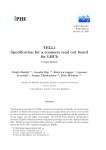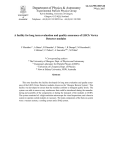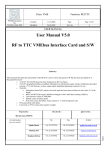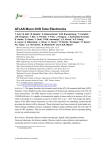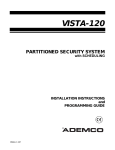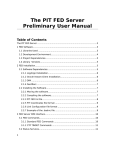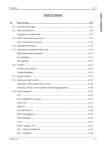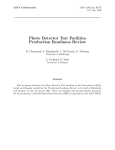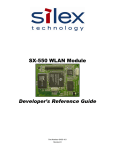Download document - Indico
Transcript
LHCb 2003-007 IPHE 2003-02 February 17, 2003 Common L1 read out board for LHCb specification Aurelio Bay a 1 , Jorgen Christiansen b 2 , Guido Haefeli a 3 , Federica Legger a, Laurent Locatelli a, Ulrich Uwer c 4 ,Dirk Wiedner c 5 . a Institut de Physique des Hautes Energies, Université de Lausanne b Cern, Geneva c Kirchhoff-Institut für Physik, University Heidelberg Abstract This document specifies the the L1 readout board used by several sub detectors of LHCb. It specifies the interface to the sub-detector specific receiver cards and all the common interfaces for the LHCb environment. 1 E-mail: E-mail: 3 E-mail: 4 E-mail: 5 E-mail: 2 [email protected] [email protected] [email protected] [email protected] [email protected] Contents 1 Introduction 1 2 Shortcuts 2 3 Requirements 2 4 L1 data flow architecture 4.1 L1 buffer . . . . . . . . . . . . . . . . . . . . . . . . . . . . . . . . . . . 4.2 DAQ readout . . . . . . . . . . . . . . . . . . . . . . . . . . . . . . . . 3 4 5 5 A-RxCard and O-RxCard 5.1 ECS access . . . . . . . . . . . . . . . . . . . . . . . . . . . . . . . . . 8 8 6 PP-FPGA 6.1 I/O count . . . . . . . . . . . . . . . . . . . . . . . . . . . . . . . . . . 8 9 7 Data synchronization and event synchronization 7.1 Data synchronization for the Velo . . . . . . . . . 7.2 Data synchronization for the O-RxCards . . . . . 7.3 Event synchronization for the Velo . . . . . . . . 7.4 Event synchronization for OT . . . . . . . . . . . . . . . . . . . . . . . . . . . . . . . . . . . . . . . 11 11 11 11 11 8 SyncLink-FPGA 8.1 32-bit L1T fragment link . . . . . . . . . . . . . . . . . . . . 8.2 16-bit DAQ fragment link . . . . . . . . . . . . . . . . . . . 8.3 VeLo cluster formats for fragment links . . . . . . . . . . . . 8.4 Conversion of Strip number to physical position for the Velo 8.5 Outer Tracker cluster format for fragment links . . . . . . . . . . . . . . . . . . . . . . . . . . . . . . . . . . . . . 12 13 15 15 16 16 . . . . . . . . . . . . . . . . . . . . 9 TTCrx interface 17 10 FEM for Beetle based read out 18 11 ECS interface 11.1 PLX parallel local bus . . . . . . . . . . . . . . . . . . . . . . . . . . . 18 20 12 FPGA technology 12.1 Altera . . . . . . . . . . . . . . . . . . . . . . . . . . . . . . . . . . . . 12.2 Xilinx VirtexII . . . . . . . . . . . . . . . . . . . . . . . . . . . . . . . 12.3 Device choice . . . . . . . . . . . . . . . . . . . . . . . . . . . . . . . . 21 21 22 22 13 L1 trigger and DAQ interface - RO-Tx 13.1 Gigabit Ethernet . . . . . . . . . . . . . . . . . . . . . . . . . . . . . . 13.2 Implementation of a dual Gigabit Ethernet on the board . . . . . . . . 13.3 Upgrade interface . . . . . . . . . . . . . . . . . . . . . . . . . . . . . . 23 23 23 24 14 Resets 24 i 15 Clock distribution and signal termination on the board 24 16 FPGA configuration 25 17 JTAG boundary scan 26 18 Power requirements 26 19 Physical aspects of the ROB 27 20 FPGA implementation guidelines 27 21 Open questions 28 A I/O Tables 31 B Register and local parallel bus address space definition 33 C I2C address definition 36 D Signal tables 37 E Pin out for connectors on the board 41 ii 1 Introduction Several sub-detectors of LHCb as Velo,ST,TT,Veto and OT have decided to use a very similar read out schemes for their detectors. In order to minimize the amount of (L1) electronics in the radiation area, the LO accepted data is transmitted directly over long analog copper (in case of the Velo) or digital optical links (for all the other subdetectors) to the counting room. With the use of the same read out chip for Velo, ST and TT, the development of a common L1 electronics read out board has been started already in the early design phase. Due to the circumstance of having two different link implementations, the L1 electronics read out board (L1-ROB) has been designed to be adaptable for the two link system. In case of the Velo, the receiver side digitizes the analog signals and for the optical links, the data serialized with the GOL chip close to the detector is de-serialized with the TLK2501 SERDES from Texas Instruments. Lack of choice, several other sub-detectors do also foresee the GOL-TLK2501 transmission leading to an identical hardware interface to the L1-ROB. For synchronization, L1 buffering, L1T zero suppression and DAQ zero suppression several large FPGAs are placed on the motherboard. This allows the adaption of the board to the special needs of processing the data. Also some parts of the FPGA firmware has to be developed specific to the sub-detectors, a common framework including all interfaces can be used by all user of the board. 1 2 Shortcuts A-RxCard Analog Receiver Card O-RxCard Optical Receiver Card RxCard Receiver Card (stands for A-RxCard and O-RxCard) PP-FPGA Pre Processor FPGA SyncLink-FPGA Synchronization and Link FPGA ROB Read Out Board FEM Front End Emulator L1B L1 Buffer L1T L1 Trigger L1A L1 Accept DAQ Data Acquisition TTCrx TTC receiver chip ECS Experimental Control System TLK2501 Texas Instruments SERDES chip GOL Cern implementation of a radiation hard 1.6-Gbit/s serializer RO-TxCard Read Out Transmitter Card DDR SDRAM Double Data Rate Synchronous Dynamic RAM SERDES Serializer and de-serializer circuit L1T ZSupp L1 trigger zero suppression OSI Open Systems Interconnect Model MAC Medium Access Controller, Gigabit Ethernet terminology PHY Physical layer device, Gigabit Ethernet terminology POS PHY Level 3 Saturn compatible Packet Over Sonet interface level 3 used for 1 Gigabit Ethernet POS PHY Level 4 Saturn compatible Packet Over Sonet interface level 4 used for 10 Gigabit Ethernet GMII Gigabit Medium Independent Interface, 8-bit parallel PHY interface 3 Requirements The L1 ROB is used by several sub-detectors in LHCb. Special requirements are given by different sub-detectors concerning interconnection and synchronization. In most aspects the Velo imposes the strongest requirements and is therefore taken to guide the implementation. In the following list, important aspects for the various subdetectors are summarized to give a general overview of the most demanding aspects of each sub-detector: • Velo – The L1 electronics interface is analog and digitization must be done on the receiver part (A-RxCard). 2 – The number of input data and clocks signals is higher than for other subdetectors since the receiver card is working as digitizer and the data is sent out to the motherboard at 40M Hz on 32-bit wide buses. – The Velo must provide the information to the L1 trigger. – An advanced common mode suppression algorithm is foreseen to be implemented for the L1 trigger pre processor and the DAQ interface. – The synchronization of the sampled data needs a local front end emulator to generate a data valid signal. • ST,TT – The data is sent multiplexed on 16+2-bit wide buses at 80M Hz from the optical receiver card (O-RxCard) to the motherboard. The higher frequency and fast signal edges of these signals need to be taken into account. – With 24 optical links on the ROB, the L1B needs to be designed for this data stream which is higher than for the Velo. – TT must provide information to the L1 trigger. • OT – The high occupancy on this detector imposes a high bandwidth for the whole readout path. 4 L1 data flow architecture In figure 1 a block diagram of the ROB is given to show its partitioning in different daughter cards and FPGAs. Four or two independent receiver mezzanine cards (ARxCard or O-RxCard)6 can be plugged onto the motherboard. The receiver card is directly connected to the PP-FPGA which is the main processing unit on the board. Each PP-FPGA uses several independent L1B and L1B controller to store the data during the L1 latency. After zero suppression for the L1T and the DAQ, the data is linked and encapsulated on the SyncLink-FPGA. The same FPGA is also used to process the TTCrx, ECS and FE emulator information to issue resets, synchronize the PP-FPGA processing, and distribute clocks and L1T decisions. The data is sent to the event building network via the read out transmitter (RO-Tx). A more detailed representation of the whole ROB is given in figure 2 for the Velo and in figure 3 for the optical read out. To reduce the number of I/O pins used on the PP-FPGA, the data from two synchronization channels are sent to one L1B controller using the full bandwidth of a 16-bit double data rate SDRAM running at 120M Hz. The event rate of 40kHz at the DAQ zero suppression allows to use a single common mode and zero suppression for all data on one chip. The slow control of the FPGAs is done with a 8-bit wide address and data multiplexed parallel interface. This interface is generated from the PCI bridge on the Glue Card and is called the ”Local Bus” of the PLX9030. The ECS interface allows to access the local 32-bit memory space containing registers, 6 Two receiver card types are foreseen, one for the Velo analog electrical readout and the other for the optical readout. 3 FE FE FE FE A-RxCard (O-RxCard) A-RxCard (O-RxCard) A-RxCard (O-RxCard) A-RxCard (O-RxCard) PP-FPGA PP-FPGA PP-FPGA PP-FPGA L1B L1B L1B L1B SyncLink-FPGA ECS ECS FEM RO-Tx TTCrx TTC L1T DAQ L1 throttle Figure 1: An overview of the building blocks on the L1 ROB. constant tables and the L1 buffers. The TTCrx, A-RxCard and the FEM are connected to individual I 2 C buses for direct ECS access. 4.1 L1 buffer A block diagram of the principle of the L1 buffer controller is shown in figure 4. The data coming from two synchronization channels are written to the L1B by one L1B controller. Its Arbiter allows to schedule the required transaction. It checks on the state of the InFifo (indicated with the UsedWords signal) and performs the read out of the L1 accepted events only if the InFifo does not risk to overflow. A possible sequence can be seen in figure 5. With a clock frequency of 120M Hz 7 enough cycles are available for arbitration and refreshing. In table 1 the necessary cycle count for each task on the SDRAM is given. The chosen SDRAM frequency leads to a sufficient high bandwidth of the memory and allows to keep the InFifos small (about 4 events)[2] 8 . 7 8 With a clock frequency 120M Hz the data transfer rate is at 240M Hz. The simulation for the L1B access with this scheme has to be verified by simulation. 4 16 Analog Electrical link from FE X4 A-RxCard (Mezzanine card) DDR @120MHz 16-bit data 13-bit addr 32 32 Sync 32 Sync Sync X4 @40MHz 32 Sync 16 L1B L1B Ctrl 16 L1B Clk Gen L1B Ctrl 16 L1B Ctrl 32 32 Analyzer IF 32 32 32 32 L1T ZSupp L1T ZSupp L1T ZSupp L1T ZSupp 8 8 8 8 @80MHz @80MHz DAQ PPLink 8 L1T PPLink DAQ ZSupp 8 1 6 To and from all 4 PP-FPGA From all 4 PP-FPGA Data @80MHz 16 Analyzer IF PP- FPGA @120MHz To PP-FPGA left and right L1A GEN Broad Cast Throttle 32 FEM Sync DAQ and L1T Link 32 TTCrx TTC Data @80MHz DataValid RO-Tx Throttle SyncLink-FPGA L1B Sync PP L0Accept FEM To event building network Figure 2: Data flow of the ROB for the Velo read out. Only one A-RxC and PP-FPGA is shown. The FIFO data buffers on the in and output of the logic blocks are indicated as small dark rectangles. 4.2 DAQ readout The readout starts with the L1T decision distributed over the TTC broadcast command which is interpreted on the SyncLink-FPGA. Over a serial link, the EvCnt and trigger 5 6 single or 1/2 12 way optical fibers from FE DDR @120MHz 16-bit data 13-bit addr X2 or X4 O-RxCard (Mezzanine card) @80MHz 16 16 Sync 16 Sync 16 Sync 16 Sync X4 16 Sync Sync 16 L1B @40MHz L1B Ctrl 16 L1B L1B Ctrl 16 L1B L1B Ctrl 32 32 32 32 32 32 L1T ZSupp L1T ZSupp L1T ZSupp L1T ZSupp L1T ZSupp L1T ZSupp 8 8 8 8 8 8 32 32 32 Analyzer IF @80MHz DAQ PPLink 8 L1T PPLink DAQ ZSupp 8 1 6 To and from all 4 PP-FPGA From all 4 PP-FPGA Data @80MHz 16 Analyzer IF L1A GEN Broad Cast Throttle Data @80MHz 32 DAQ and L1T Link SyncLink-FPGA @80MHz PP- FPGA @120MHz To PP-FPGA left and right 32 TTCrx TTC RO-Tx Throttle To event building network Figure 3: Data flow of the ROB for the optical read out. The diagram shows the data flow for 6 optical links and the linking on the board. type is transmitted to the PP-FPGA. The Arbiter reads the requested events stored at the start address given by the EvCnt. With the EvCnt also stored in the event header the correct operation can be checked for each event. The events are collected in the DAQ-PPLink and zero suppressed in DAQ-ZSupp. The data from all PP-FPGAs on 6 From RxCard Data DDR SDRAM CTRL @120MHz (IP CORE) RdData 2x16-bit@ 120MHz Addr WrData 16 InFifo InFifo RdReq Select WrEvCnt WrEvCnt RdReq WrReq 32 32-bit @ 40MHz L1T ZSupp RdAddr Sync InFifo 16 WrAddr 32 UsedWords 13 Sync InFifo MUX 16 256-Mbit DDR SDRAM 2x16-bit@ 120MHz L1B controller L1T ZSupp To L1T PPLINK Arbiter 32 RdEvCnt Data to DAQ_PPLink From SyncLink_FPGA Rd/Wr access for ECS Figure 4: Detailed L1B controller block diagram. Rate Task Cycle count Each event Write CH0 2.5+34 Each event Every 2 events Every 2 events Every 25 events Every 25 events Every 8 events Write CH1 Active Precharge Read CH0 Read CH1 Refresh 34 3 3 6+2.5+34 34 10 Cyles available Average Cycle 108 per event 78 per event Remark Data transfer is 2 word per cycle Performed after CH0 writing Activate the row (open) Deactivate the row (close) Performed after CH0 reading Refresh once per 7.8µs 900ns/8.3ns 72% Table 1: SDRAM cycle access statistic. Write CH0 CH1 CH0 CH1 Read CH0 CH1 CH0 CH1 CH0 CH1 CH0 CH1 Refresh R 0 1 2 3 4 5 time [900ns] Figure 5: Example how the Arbiter schedules the required transactions. 7 the board are linked and encapsulated on the SyncLink-FPGA to be finally sent to the RO-Tx. To unload the task of the PP-FPGA and its need of resources, the DAQ zero suppression can optionally also be performed on the SyncLink-FPGA. Doing so, all raw data from the whole ROB can be linked before being zero suppressed. 5 A-RxCard and O-RxCard At present, two different receiver daughter card implementations are foreseen to be plugged on the motherboard. This is necessary due to the different data transmission system from the cavern to the counting room. For the Velo, the receiver card is used to digitize the data transferred over analog copper links [6] and therefore is a mainly analog circuit with pre-amplifier, line-equalizer and ADC. This card is called A-RxCard. The optical receiver card is used by all other sub-detectors as IT, TT and OT. It uses optical receiver and de-serializer which results in a mainly digital design except for the optical receiver part. This card is called O-RxCard. The signal connection from the receiver cards to the motherboard is split up into 4 separate connectors. The physical placement is chosen such that 2 or 4 mezzanine cards can be inserted, giving flexibility for the receiver card design. Table 18 shows the number of digital signals on the signal connector for different implementations. The connector chosen provide massive copper plate for GND and Vcc connection and ensures very good signal integrity properties 9 . The motherboard is designed to allow 64 analog links digitized with 8 or 10-bit 10 for the A-RxCard. The number of pins needed for the RxCard is driven by the A-RxCard. In addition to the signal connectors, analog power connectors are used to supply the RxCard with all necessary analog power (see table 19). All control signals for the O-RxCard are assigned to pins of the not used data signals ( 160 data signals are used for the Velo and only 108 for the O-RxCard) which minimizes the number of required pins on the connecter. 5.1 ECS access I 2 C is used for the slow control the RxCard. The four cards share the address space of one dedicated I 2 C bus where the two highest address bits (bit 6 and 7) are defined on the motherboard (see table in appendix 17). All other bits have to be set on the receiver cards. 6 PP-FPGA With a long list of tasks this FPGA demands for a high amount of resources. Detailed studies for the implementation of the zero suppression for the the L1T called L1PPI have been done in [1] to estimate the amount of logic gates and memory needed on the PP-FPGA. In table 2 an overview of the estimated resources is given for the 9 For the digital signal connectors a 200 pin, 0.643mm pitch connector has been chosen (see. http://www.samtec.com/ftppub/pdf/QTS.PDF and http://www.samtec.com/ftppub/pdf/QSS.PDF 10 Using a 10-bit ADC is optional for the A-RxCard and therefore it needs to be supported by the ROB. The further processing will be done on 8-bit resolution. 8 implementation of the LCMS algorithm also described in [1]. The implementation has been optimized for the Altera APEX20K FPGA architecture but also allows to estimate the resources used in an other FPGA. Using the Altera Stratix FPGA devices allows to implement the MAC (multiply accumulation) operations with the embedded DSP blocks. This reduces significantly the LEs (logic elements) used for the design. Functional block Logic Elements (LE) Block memory 512 bit Block memory 4k Block memory 4k x 144 DSP blocks PLL L1 trigger ZSupp ⊕DAQ ZSupp L1B Synchronization ADC clock gen. Total 6000 3000 3000 1000 200 13200 60 20 0 0 0 80 8 12 12 12 0 44 0 0 0 0 0 0 60 20 0 0 0 80 1 0 1 0 2 4 Available in 1S20 18460 194 82 2 80 6 Available in 1S25 25660 224 138 2 80 6 This is the estimated number with the assumption that the processing is done with 160M Hz. ⊕ The zero suppression can also be done on the SyncLink-FPGA, which reduces the resources needed on the PP-FPGA. Table 2: Estimation of needed resources on the PP-FPGA. For sub-detectors not contributing to the L1 trigger, the logic resources on the chip are available for other tasks. 6.1 I/O count To determine the package size of the FPGA a detailed count of the I/O is listed in table 10. The number of data signals plus the I/O pins used for reference voltage of the SSTL-2 and the reference impedance for the source termination are also included in this calculation. The calculated number of I/O is supported by several packages and devices of the Altera Stratix FPGAs. To allow the migration between different devices the necessary number of I/O has to be available by all desired devices. 9 Altera Stratix (Cyclone) Device 400-Pin FineLine BGA EP1S10 EP1S20 EP1S25 EP1S30 EP1C20 672-Pin FineLine BGA 780-Pin FineLine BGA Comment 341 422 469 422 582 593 593 not enough I/O 301 biggest Cyclone device Table 3: The 780-pin FBGA package allows to migrate between several devices. 10 7 Data synchronization and event synchronization For a better understanding of the synchronization mechanism on the board it is useful to distinguished between data and event synchronization. In this context data synchronization comprises the generation of the sampling clock of the ADC for the A-RxCard, selecting the valid data out of the continuous sampled analog signals and changing the clock domain on the input stage of the FPGA to the on chip common clock domain. For the optical receiver card the data synchronization is given by the interface of the deserializer. The event synchronization is a second step and performs consistency checks between the transmitted event identification in the header and the local reference. This separation can be understood as a two layer transmission model where the data synchronization is on the Physical layer and the event synchronization is the DataLink layer of the OSI model. 7.1 Data synchronization for the Velo The analog signal transmission over 40m twisted pair copper links suffer from a skew among channels on the same cable of order 5ns which has to be compensated by using channel individual phase adjustable clocks for sampling the signals. These clocks are generated using the PLL circuits on the PP-FPGAs. The details of its implementation are given in [3]. The data valid signal available on the Velo FE-chip (Beetle) is not transmitted to the read out electronics over the analog links. The principle to select the valid data from the continuous sampled signals is based on the data valid signal regenerated by the local FEM. The data has further to be synchronized to the common 40M Hz clock domain which is done by the use of FIFOs on the input stage. The synchronization is illustrated in figure 6. 7.2 Data synchronization for the O-RxCards The TLK2501 SERDES chip used on the O-RxCards is generating the clock, data enable and an error signal which are used to synchronize the data on the input of the PP-FPGA. The multiplexed data is de-multiplexed and written to an input FIFO to allow the change of clock domain for the following processing stages. The independent synchronization of each optical input link makes the skew between the optical channels not an issue. 7.3 Event synchronization for the Velo After the valid data is masked, the header words representing the pipeline column number (8-bit PCN) can be verified. This is done among the neighboring channels and the reference from the FEM. 7.4 Event synchronization for OT The data headers from the OTIS TDCs (??) include a 8-bit BCnt that will be compared to the BCnt generated on the board. On error the BCntError bit will be set. The BCnt will be used together with the TDC ID to do the de-serialization from 80M Hz 11 FIFO DC ADC_clk Clk_40 Data WR Wr_req Data Check: PCN ADD:BCnt,EvCnt Rd_req I2C SyncEvCntStr SyncBCntStr SyncPCNStr Clk_40 SyncData<5:0> Valid Delay SyncDataValid Sync Data RD ZSupp Analog input data ADC 8(10)-bit PP-FPGA Clk_40 Clk Generator Reset I2C L0Accept FEM (Beetle) Clk_40 EvSync Data<3:0> TTCrx interface TTCrx DataValid SyncLink-FPGA Figure 6: ADC input data synchronization for the Velo. to 40M Hz. After error checking and verification of the correct data header for each Otis, the EvCnt and BCnt will be added to the data and stored in the L1B. 8 SyncLink-FPGA Cluster A cluster is formed when one or multiple neighboring detector channel carry a signal. The proposed cluster size for the L1T is one 16-bit word. The cluster size for the DAQ is variable depending on the number of hits in the cluster but is transmitted in 16-bit words. Event fragment All clusters for one event on one PP-FPGA is called an event fragment. This FPGA is used to distribute control signals, interfacing the TTCrx and the FEM, linking the cluster fragments from the whole board and sending the data to the RO-Tx. The cluster collection uses FIFO based interfaces from the PP-FPGAs to the SyncLinkFPGA. The FIFOs are either located on the input stage of the SyncLink-FPGA as a baseline or optional for sub-detectors using the SyncLink-FPGA for the DAQ zero suppression, on the PP-FPGA. The links to collect the clusters on the L1T interface 12 Clk RO-TxClk ECSClk Clk_40 Status LED Clk_80 Clock Generator BrdRst Broad Cast CMD TTCrxRst BCnt L1A Generator Clk_40 L0Reset SyncData Generator PCN Throttle SyncDataStr 36 Location Conv RAM From PP-FPGA’s @80MHz 16 DAQ Link & Encapsulation F I F O 64 64 32 L1T Link & Encapsulation F I F O Analyzer IF EvCntReset,BCntReset SyncData 6 Throttle OR RO-Interface To RO-Tx 1 L1AStr @80MHz FEM SyncRst L1EvIDReset L1Accept L1A FIFO 12 Reset Generator FIFO TTCrx To PP-FPGA’s Brcst 32 10 SyncLink-FPGA Figure 7: Data flow overview of the SyncLink-FPGA are chosen 32-bit wide for the L1T and 16-bit for the DAQ. The functionality foreseen at the present to be implemented for the Velo,ST/TT and OT does not demand a high amount of logic resources on this FPGA. An estimation is given in table 4. 8.1 32-bit L1T fragment link With a transfer rate of 80M Hz and a cluster size of 16-bit, the data transfer is restricted to 128 clusters plus the header each event, leaving a margin of 10 cycles for start and 13 Functional block Logic Elements (LE) Block memory 512 bit Block memory 4k Block memory 4k x 144 DSP blocks PLL L1T fragment link L1T location conversion DAQ fragment link Control generators RO-Tx interface Total 1000 0 1000 2000 1000 5000 0 0 0 0 0 0 8 8 8 8 8 40 0 0 0 0 0 0 0 0 0 0 0 0 1 0 0 2 1 4 Available in 1S20 18460 194 82 2 80 6 Table 4: Estimation of needed resources on the SyncLink-FPGA. stop the transfer 11 . Additional hits or clusters need to be discarded to allow the linking to be performed with a fixed latency of 900ns. Fixing the event linking latency prevents from possible buffer overflows at the FIFO buffers. The fragments with discarded clusters are flagged as such in the ErrorFlag word. If a higher bandwidth on these links is needed, the clock frequency can be increased up to 160M Hz without any changes on the link hardware 12 . The increase of the bandwidth on the board is general less critical then the link bandwidth to the L1T event building network. To transmit 128 16-bit clusters / event needs a minimal bandwidth of 4-Gbit/s. Velo To find the most appropriate cluster encoding schema the distribution for 1, 2 or multiple hit clusters has been simulated and the most appropriate data model has been discussed [4]. With an expected occupancy of order 0.6% or an average of 15 clusters/board/event [8]the most reasonable cluster encoding is the following: • One hit clusters are marked as of size 1 and its strip number is transmitted. • Two hit clusters are marked as size 2 and the strip number of only the first strip is transmitted. • Clusters with three and more hits are split up into clusters of size one and two. To allow a flexible limitation of the readout data, the maximal number of clusters sent to the L1T can be limited at the two linking stages. The limits can be set per PP-FPGA and for the whole ROB on the SyncLink-FPGA. ST/TT As for the Velo. OT With 6 optical links per PP-FPGA, a total of 1536 channels are processed on the ROB. The restriction to 128 hits/event per PP-FPGA allows to read out a maximal local occupancy of 33%. With a zero suppression that allows to encode 11 Available cycles: 900ns/12.5ns=76, Cycles not used: 76-2-128/2=10 The point to point links are terminated with serial resisters on the source side which is implemented in the FPGA I/O structure. The perfect termination allows to run at high frequencies. 12 14 multiple hits in one cluster a significant data reduction can be obtained. With the assumption that only binary information per hit needs to be sent to the L1T, the non zero suppressed information on the fragment link is 384-bit or 24 16-bit words, which is equal to an occupancy with single hit encoding of 6.25%. This value is an upper limit to the necessary bandwidth . 8.2 16-bit DAQ fragment link To link and transfer the DAQ fragments an average time of 25µs is allowed 13 . The 16-bit wide links permit to transfer the event fragments without the need of deep FIFO buffers. Also the bandwidth allows to transfer very long fragments, a restriction on the length of the fragments can help to avoid overflows and is foreseen to be implemented as a value to be set on the FPGA. In figure 8 the event fragment format is given for both links. DAQFragmentFormat,16 L1TFragmentFormat,32 R,4 R,4 BCnt, 12 Cluster(2), 16 Cluster(4), 16 Cluster(6), 16 ErrorFlag, 8 N, 8 EvCnt, 16 Cluster(1), 16 Cluster(3), 16 Cluster(5), 16 Unused or Cluster(N), 16 TriggType, 4 EvCnt(3:0),4 DataLength DL, 12 BCnt, 12 EvCnt(23:4), 16 ErrorFlag, 8 PCN, 8 ClusterHeader(1,1),16 ClusterData(1,2), 16 ClusterData(1,3), 16 N Cluster(N), 16 ClusterData(1,L1), 16 DL ClusterHeader(N,1), 16 ClusterData(N,LN), 16 Figure 8: Link format for L1T and DAQ between PP-FPGA and SyncLink-FPGA. 8.3 VeLo cluster formats for fragment links The L1T cluster in case of the Velo has the following format: The DAQ event fragment Bit 0 < 12 : 1 > 13 < 15 : 14 > Description Cluster size Is 0 for clusters of one hit and 1 for two hits Strip number Unique strip number on the ROB Second threshold If one of the hits in the cluster exceeded the second threshold level this bit is set. Unused Table 5: Velo cluster format for the L1 trigger. 13 With a L1 accept rate of 40kHz. 15 Comment do have a more complicated structure. In case for the Velo the following information is sent to the DAQ wrapped in 16-bit wide words: Size 4-bit 8-bit 12-bit Nh x 8-bit 4 x 8-bit Description Cluster size Number of data words in the cluster. L1T information The result of the L1T pre-processor algorithm for each strip value (hit and second threshold) NStrip Strip number of the first hit in the cluster. Strip values Nh is the number of hits in a cluster. Neighbor strip values The two right and left neighboring strip values to the cluster. Table 6: Velo cluster format for the DAQ. 8.4 Conversion of Strip number to physical position for the Velo Each strip number on the board (11-bit for 2048) has to be converted in a physical location according to the alignment tables calculated off line and downloaded to the SyncLink-FPGA. The size of the alignment table of (2k x 12 bit or 32kbit ) which corresponds to a physical resolution of about 5µm. This table can be implemented either in 8 x 4kbit memory blocks or in one 512 kbit also available on the SyncLinkFPGA. 8.5 Outer Tracker cluster format for fragment links In preparation 16 9 TTCrx interface The TTC receiver chip synchronization signals are connected to the SyncLink-FPGA (table 21). The distribution of clock, trigger and event synchronization signals is done with point to point links to each PP-FPGA. The clocks can be individually phase adjusted to ensure the correct clock phase between the FPGAs on the board. The configuration registers can be loaded over an ECS driven I 2 C bus. For production testing the JTAG boundary scan interface is connected to the overall JTAG chain. The used of a configuration EEPROM is not foreseen and the configuration registers have to be loaded at each power up. The TTCrx is directly mounted on the board to reduce cost and board space 14 . For further documentation refer to the TTCrx user manual [9]. The The following synchronization tasks are implemented on the SyncLink-FPGA using the TTTrx signals 15 : TTCrx reset All resets on the board are distributed from the SyncLink-FPGA (see section Resets). TTCrx status DbErrStr and SinErrStr are counted with saturated 16 16-bit counters and are accessible on the ECS registers TTCErrCntReg. TTCReady is accessible on BoardStatReg. Clock The Clock40Des1 is used for the board wide 40M Hz clock called clk 40. The PLL based clock management circuit on the SyncLink-FPGA allows to distribution the system clock to all necessary locations without external clock buffers. The Clock40 and Clock40Des2 are also connected to the SyncLink-FPGA but are not used yet. BCnt The bunch counter is available on the BCnt bus during the BCntStr high, synchronized to the Clock40Des1 and reset by BCntRes. The bunch counter is transmitted to the PP-FPGAs via 6-bit wide SyncData bus and therefore has to be multiplexed during two clock cycles. The timing diagram for the SyncData and its strobe signal SyncStr is given in 10. EvCnt The low part (12-bit) of the event counter is available on the BCnt bus during the EvCntLStr high and the high part during EvCntHStr high. The BCnt signals are synchronized to the Clock40Des1 and reset by EvCntRes. The event counter is also transmitted on the SyncData bus over four clock cycles. Brcst The setting of the TTCrx is made such that the broadcast command data signals are all synchronous to Clock40Des1, the appropriate settings are made on the control registers of the TTCrx. The broadcast command is used to decode the LHCb L1 accepted events (see the broadcast command figure 9). L1 accept The TTCrx signal called L1accept is named L0acceptLHCb to avoid any problems with the LHCb naming convention. It is used for the Velo FEM and is also used to generate the EvCnt independent of the TTC BCnt which allows to verify the correct synchronization. 14 The chip is packaged in an 144-pin FBGA package (13mm x 13mm) Signals named Str at the end are strobe signals and are used to latch the corresponding data bus. 16 At overflow the value of the counter remains at 0xffff. 15 17 For the optical receiver the Agilent HFBR-2316T is used, which is recommended for the use for the TTC system in the counting room 17 . Trigger type: 0: Reject 1: Physics 2-7: Resvd LSB of event ID L1 trigger 1 Reset 0 1 Resvd CMD1 (calibration) 0 0 0 1 CMD2 (Resvd) CMD3 (Resvd) 0 0 0 0 1 1 0 1 L1 event ID reset L1 front- L0 frontEvCnt end end reset reset reset Calibration pulse type: 0: Default 1-3: Resvd x x x x BCnt reset Figure 9: Broadcast command interpreted by the SyncLink-FPGA defined for LHCb. 10 FEM for Beetle based read out The FEM used by the sub-detectors with the Beetle FE-chip [10] is controlled with I 2 C and interfaced to the SyncLink-FPGA. Its task is to generate the DataValid signal which is not transmitted with the detector data. In addition the the PCN is extracted to check the synchronization between the FEM and the data from the FE. In addition the available status signals from the Beetle are also connected to the SyncLink-FPGA and made available in a register for status monitoring. In table 22 in the appendix, the signals on the FEM interface are given. The PCN is available on the FEMData bus and has to be sampled with respect to the FEMDataValid signal as shown in the timing diagram figure 10. The FEMData bits have to be re-ordered as indicated, the upper 4 bits are not used. The distribution of the 8-bit PCN to PP-FPGA is done on the SyncData bus. The strobe signal SyncPCNStr generated is used by the PP-FPGA to latch the data on the SyncData bus. The PCN is transmitted over the SyncData bus to the PP-FPGAs and has to be multiplexed on the SyncLink-FPGA. The definition of the header data bits sent by the Beetle FE chip is given in the specification of that chip. The PCN is sent over two clock cycles via 6-bit wide bus from the SyncLink-FPGA to the PP-FPGAs. 11 ECS interface With the use of the LHCb specific CC-PC and the adaption Glue Card, all necessary interfaces are provided. 17 http://literature.agilent.com/litweb/pdf/5988-2576EN.pdf 18 Clk_40 L0Accept PCNa FemData<3:0> PCNb D0 D1 PCN0 PCN1 D2 D3 D4 D5 D6 D7 EvC0 EvC1 EvC2 EvC3 D30 D31 DataValid SyncData<5:0> BCnt0 BCnt1 SyncStr Figure 10: Timing for the FEM signals in the upper part and its output from the SyncLink-FPGA to the PP-FPGA in the lower part. JTAG It is used to program the EEPROM containing the firmware code for the FPGAs. JTAG is also used for boundary scan used for production testing but this chain is separate from the programming chain and not connected to the ECS. I2C Multiple I2C buses are used on the board. Four independent buses are provided by the Glue Card, allowing individual buses for (see figure 11): SyncLink-FPGA PP-FPGA FPGAI2C RxI2C CC-PC PCI FEMI2C Glue Card RxCard b”00xxxxx” b”001xxxx” b”011xxxx” b”101xxxx” b”111xxxx” b”00xxxxx” b”01xxxxx” b”10xxxxx” b”11xxxxx” FEM b”0000000” TTCrx b”000000x” BRD ID EEPROM b”1010000” TTCI2C JTAG FPGA Firmware EEPROM Figure 11: Overview of the 4 I2C buses and their address spaces defined by hardwired pins on the motherboard. Only one JTAG controlled device is on the boards. • I2C for the RxCards (RxSda,RxScl) • I2c for the TTCrx (TTCSda,TTCScl). The serial EPROM for the board identification is connected as well to this bus. 19 • I2C for the front end emulator Beetle chip (FEMSda,FEMScl) • I2C FPGA, all FPGAs are connected on I2C for debugging purpose (FPGASda,FPGAScl) Parallel local bus The local bus generated by the PLX9030 18 PCI bridge provides a simple parallel bus. Three chip select signals have to be made available. The chip selects are used in the following way (see figure 12): 8 nCS1 SyncLink-FPGA h” 00” - h” 7F” nCS1 CC-PC PCI 8 Glue Card PP-FPGA – h” 9F” – h” BF” – h” DF” – h” FF” nCSaux0 16 16 h” 80” h” A0” h” C0” h” E0” RO-Tx h” 0000” - h” FFFF” Ctrl IF Connector h” 0000” - h” FFFF” nCSaux1 Local parallel bus Multiplexed mode @ 10 MHz Figure 12: Overview of the 3 local parallel nCS and their address spaces. • nCS1 for the SyncLink-FPGA and the PP-FPGA’s, to access the the registers described in table 16. L1B, on chip RAM and many other registers are accessed indirect through the defined address, data and transfer control registers. • nCSaux019 is used for the local bus to the RO-Tx. • nCSaux1 is reserved for a local bus going to the control interface connector. 11.1 PLX parallel local bus The parallel local bus is used to access all user registers, on chip memories and the L1Bs. It is used in the 8-bit multiplexed mode running at 10M Hz. The 8-bit address space is used to access the address, data and transfer control registers, in order to access the local address spaces on the FPGAs. Each FPGA has an individual local address space with an address width of 32-bits. To simplify the access of different size of registers, the read and write operation on the chip can be done with a data width of 8-bit, 16-bit or 32-bit. The transfer type is marked in the transfer control register for each transaction. To do a 32-bit wide access to the local memory space the following operations have to be issued: 18 See the documentation of the PLX9030 for the functionality of the local bus http://www.plxtech. com 19 The two auxiliary chip selects have to be generated from the the GPIO pins. 20 (7:0) TCtrl (31:24) Addr3 Local address space access registers (23:16) (15:7) (7:0) (31:24) (23:16) Addr2 Addr1 Addr0 Data3 Data2 (15:7) Data1 (7:0) Data0 Table 7: Data, address and transfer control registers to access the local 32-bit address space. • If it is a data write operation, write the data to the data registers. According to the width of the data transferred only one, two or all four data registers have to be set. • Write the whole 32-bit wide address to the 4 address registers. • Write to the transfer control register the required command according to definition in reftctrlreg to issue the read or write transfer. • If it is a data read operation, read the data from the data registers that are set after the transfer command has been issued. 12 12.1 FPGA technology Altera The evolution of FPGA technology has driven the devices to higher density, faster on chip processing, and faster I/O capability. The development is mostly driven by the telecommunication industry which is also doing multichannel processing on the FPGAs. There is nevertheless a major difference on the demand of I/O performance. For the ROB only single ended 40M Hz,80M Hz and 120M Hz interconnect signals are used. The standard currently supported by FPGA families are e.g. 840M bps or 3.125Gbps. This circumstance should not mislead to the conclusion that these chips are overkilled to use. Price investigation for high density FPGA device for the present and the near future show that the most recent devices family will cost less than e.g. Altera Apex devices. This can be explained with the miniaturization of the silicon process to 0.13µm which allows to reduce production cost. In an uncomplete list of features, the advantages of the Stratix devices over the Apex is shown. For details see the specification and application notes on the Altera web site 20 . On chip memeory Fast and flexible embedded memory block structure with block sizes of 512bit, 4kbit and 512kbit. Power and I/O Low power consumption due to low core voltage. I/O Support of a wide range of current signaling standard at its I/Os. Fast The device allows to process the L1T zero suppression at 160M Hz. Therefore 4 data channels can be processed multiplexed on one algorithm processing block. 20 http://www.altera.com 21 Termination Termination of the interconnects of the traces on the PCB is possible on the chip. This increases significantly the allowed density of fast signals. PLL Allows a flexible clock management and replaces clock buffers on the board. DSP blocks Embedded multiply accumulate blocks help the to be less critical for speed and reduces significantly the number of needed LEs. 12.2 Xilinx VirtexII The Xilinx VirtexII 21 family is also suitable for the needs of the ROB. Devices with the necessary resources are available. The architectural differences between Stratix and VirtexII are given by the size of the embedded RAM blocks, the width and modularity of the DSP multiplier blocks, DDLs instead of PLLs... . To compare the two device families a table of performance in maximal frequencies is given: Function 16-bit adder (reg to reg) 32:1 MUX (reg to reg) Frequency in MHz for Xilinx VirtexII 239 323 Frequency in MHz for Altera Stratix 239 216 64 x 8 Distributed RAM 32 x 18 M512-Block RAM 294 - 242 1k x 9 Block RAM 128x18 M4k-Block RAM 16k x 36 512kbit RAM 250 - 222 212 18x18 Multiplier 105 206 Table 8: Xilinx VirtexII Speed grade -5, second fastest out of 3 compared to Altera Stratix Speed grade -7, slowest out of 3. 12.3 Device choice Several reason have driven the decision to use Altera Stratix devices on the board. Migration The migration between devices in the low density device region of the Stratix family allows to have relatively low cost migration to higher density devices. The VirtesII family devices with equivalent size are in the high density region of the family and tend to get very expensive. Memory With the three different memory block sizes, the memory bits can more efficiently be used in our application. DDR SDRAM interface Dedicated read data clock (DQS) delay circuits for DDR SDRAM. 21 http://www.xilinx.com 22 PLL vs DLL PLL are more suitable for clock distribution since they do not suffer from additional jitter after each frequency translation step. Cost and speed The slowest speed grade Stratix device is sufficient fast. 13 L1 trigger and DAQ interface - RO-Tx The interface to the DAQ and the L1T 22 is implemented using Gigabit Ethernet running on copper. To reduce the overhead of the protocol a compact transport header has been defined for the L1T [?]. The physical implementation of the MAC and the PHY is chosen to be implemented directly on the motherboard. This reduces significantly the cost and the occupied space on the board. To overcome the disadvantage of a not upgradeable implementation, a second interface for future use is implemented. 13.1 Gigabit Ethernet With a direct implementation of the link on the motherboard several possibilities are feasible which can not be done on a mezzanine card due to the electrical constraints of interface signals. A large number of devices exist with a PCI interface used on basically all Gigabit Ethernet NICs. The disadvantage is the high number of pins on the FPGA used for the PCI-X interface (97) and the need of an additional PCI bridge to implement a control interface from the CC-PC to the MAC PCI bus. For the switch market, dedicated interfaces for Link and PHY layer devices (POS-PHY-Level 3 (PL3)23 ,POS-PHY-Level 4 (PL4), Utopia Level 2,SPI Level 3,...) are currently used. The POS-PHY Level 3 is a unidirectional, FIFO like, point to point interface running at up to 104M Hz using a 8,16 or 32-bit wide bus. The maximal transfer rate is up to 2.4 Gbit/s and is sufficient to transfer data of two Gigabit Ethernet channel. All recent FPGAs also support the PL4 interface which is the corresponding interface for 10 Gigabit Ethernet. The Level 4 interface is based on a 16-bit data bus signalling with differential LVDS at up to 622M Hz. 13.2 Implementation of a dual Gigabit Ethernet on the board The implementation is using the dual channel Ethernet MAC PHY chip from PMCSierra. The chip is equipped with the PL3 interface on the Link layer side and is driving independent GMII interfaces to each PHY. For the PHY chip the Marvell 24 ”Alaska II 88E1020 (Dual-Port) Transceiver” can be chosen. To control the PM3386 the local parallel bus from the ECS Glue Card is used in 16-bit multiplexed mode. Parameter settings and statistics of the MAC transactions can be directly accessed by the ECS. On the Link layer side, only the transmission interface from the SyncLinkFPGA to the MAC-PHY is implemented. The receiving data path is not used on the FPGA. The PL3 compliant interface is used in 32 − bit@104M Hz. The firmware on 22 The final choice for the physical implementation of the L1T event building network has not been made yet. Gigabit ethernet is nevertheless assumed for this design. 23 POS-PHY is a standard developed by PMC-Sierra http://www.pmc-sierra.com 24 http://www.marvell.com 23 the SyncLink-FPGA can be either developed specific for our application or using the PL3 to Atlantic interface FPGA core from Altera. 13.3 Upgrade interface A PL4 interface is provided on a connector using the high speed I/Os available on the SyncLink-FPGA to allow future upgrades of the DAQ and L1T link. The bandwidth of this interface is depending on the clock frequency of the LVDS signals up to 16 x 622-Mbit/s = 10-Gbit/s. In addition a second connector with the local parallel bus control interface is placed such that a PMC sized mezzanine card can be connected. The connector for the PL4 interface can not comply to the PMC standard for signal integrity reasons. 14 Resets • All resets are distributed from the SyncLink-FPGA • Each FPGA has a local reset accessible by ECS • One board push button 15 Clock distribution and signal termination on the board Special care has to be taken for the clock and fast signal distribution on the board. The typical rise/fall time for fast signals from and to the FPGAs and ASICS as the TLK2501 is 1ns. This leads to a maximal trace length of 2.4cm that can be considered as electrical ”short” with the l/6 rule [11]. All ”long” signals have to be terminated in an appropriate fashion. The preferred termination scheme for LVTTL signals is to use point to point interconnects with source termination. The value of the serial resistor is depending on the driver’s impedance and the trace impedance. In most the cases on this PCB, a serial resistor of 33 Ohms is appropriate. Parallel termination can not be applied due to the lack of driving strength and too high power dissipation that results by choosing an other electrical standard. All signals driven by the FPGAs can be terminated by programming the I/O cell to use the on chip termination option. For the DDR SDRAM the SSTL-2 I/O standard developed for memory bus systems is making use of parallel termination and is fully integrated in the memory and the I/O cells of the FPGA. With the use of the SSTL-2 I/O standard and the TLK2501 uses 50 Ohm transmission between the optical receiver and the serializer, all signal layers on the board are chosen to be 50 Ohm. The clock distribution on the board is accomplished with PLL circuits on the FPGAs for de-skewing and multiplying the clock signals (see figure 13). The Clock40Des1 40M Hz clock from the TTCrx is taken as the reference for all circuits using the LHC system clock and is connected to the SyncLink-FPGA. The distribution to the various circuits on the board, the PLL circuits on the SyncLink-FPGA are used. This allows to adjust the clock phase individual for each external circuit and ensures the proper timing between the them. In addition 24 RxCard (Mezzanine card) ADC CLK ADC CLK PLL x1 PLL x1 To L1B Ctrl ZSupp PLL x4 DAQ Link 40MHz Devider 10MHz ECS TTC L1T Link Clock 80 PLL x2 40MHz TTCrx To ZSupp 80MHz Clock 40 2 PLL x1 CC-PC 160MHz PP- FPGA L1B L1B PLL x3 SyncLink FPGA 120MHz Only for A-RxCard, for O-RxCard clocks are inputs to PP-FPGA 8 8 Clock 100 PLL x2.5 60-100MHz FEM RO-Tx 125MHz OSC Gigabit Ethernet Figure 13: Overview of the clock distribution on the ROB. Only clock signals are drawn. to the 40M Hz system clock a x2 multiplied 80M Hz clock is distributed to the PPFPGAs. This clock is used for the link interfaces for the L1T and the DAQ. With this distribution scheme no external clock buffers are needed and a maximal flexibility can be achieved. Event the ECS local parallel bus is running at 10M Hz only, care has to be taken that no fast signal edges are causing overshoot and undershoot that can destroy the devices on the bus 25 . Signal integrity simulation need to be done in order to ensure its proper functioning. 16 FPGA configuration For the configuration of the Altera Stratix FPGA one enhanced configuration device EPC16 is sufficient with the assumption, that the PP-FPGAs do have the identical firmware. The EPC16 device is programmed over JTAG controlled by the ECS. Optional two connecters are available on the motherboard to download the firmware directly to the PP-FPGAs or the SyncLink-FPGA. The EEPROM used on the EPC16 25 Remark that the PLX9030 is one of the driver of the local bus. Because the local bus is specified to operate at a frequency of up to 60M Hz, the edges of the local bus can be much faster than it is needed for the 10M Hz operation. 25 is a 16-Mbit flash memory manufactured by Sharp. The minimal number of erase cycle is 100’000 26 . 17 JTAG boundary scan All devices supporting JTAG boundary scan are chained together. For production testing the external boundary scan cable device is connected to this chain with a 10pin connecter. 18 Power requirements A list of all power supplies and its estimated current is given in table 9. For the FPGAs a power calculation spread sheet has been used for the estimation. The +5V Description 2 x O6-RxCard 2 x O12-RxCard 4 x A-RxCard 4 x PP-FPGA 12 x DDR SDRAM 1 x SyncLink-FPGA 1 x EEPROM for FPGA 1 x TTCrx 1 x Optical Rcv 1 x FEM (Beetle) 1 x MAC PHY 2 x PHY 1 x OSC 125MHz 2 x Magnetics 1 x Upgrade module 1 x CC-PC 1 x Glue Card 1 x EEPROM BrdID 1.5V Total 10A 1.8V 8A 2.5V 1.4A 2.8A 6A 1.4A 2A 2A 3.3V 1.2A 2.4A 3.9A 2A 5V -5V 2.4A 1A 0.5A 0A Comment option option option power calc. power calc. Used for config only 50mA 9 mA 1mA 0.37A ? A 0.4A 12.2A estimation 0.2 A ? A 35mA 6mA 0.2 A 0.2A 0.2A 0.4mA 9.7A 3W 1A 0.5A 3.9A estimate estimate 1A Table 9: Table of estimated currents for all components on the board. and -5V analog power supply are distributed on the backplane and are separated from the digital. The low voltage power supplies as 1.5V(10A),1.8V(0.4A),2.5V(12.2A) and 26 The number of erase cycle for the smaller EPC devices is significantly lower (100). 26 3.3V(5.8A) have to be generated on the motherboard 27 . In order keep the power dissipation low, these need to be implemented with PWM switched power supplies which have a typical efficiency of 85 to 90%. The 1.8V is used only for the RO-Tx and uses linear regulators. Option 1 The low voltage power supplies 1.5V (20A), 2.5V (20A) and 3.3V (10A) are located on the motherboard. These supplies do run on 48V input voltage which leads to an estimated current on this supply of 1.5A per board. Option 2 Distribute 5V and 3.3V on the backplane and use non-isolated DC/DC converter on the 5V for generating the 1.5V and 2.5V (requires 11A@5V ) Option 3 Distributing only 5V digital on the backplane and generate all other voltages with non-isolated switched power supplies (requires 15A@5V ). The total power consumption estimated is 75 Watts per board. 19 Physical aspects of the ROB The layout of the board is driven by two major constraints. • The A-RxCard needs to have a maximum width to allow a reasonable analog circuit layout. No other connectors can be allowed on the same panel. • All other interfaces and the power supply has to be squeezed on the other side of the board. The approach taken is the following: The data signals are connected to the front panel. For the optical receiver cards the optical fibres take a small space. The analog signals are connected with 37-pin DSUB connectors (4 per ROB). On the back side, the top region is reserved for the power back plane. The optical and electrical connectors for the TTC, ECS, L1T, DAQ and Throttle are plugged manually from the back which is accessible since there is no transition module in place. 20 FPGA implementation guidelines To allow several groups to work on the software and firmware development for the ROB, it is necessary to define the interfaces of the board, chips and functional blocks on the chip. The timing specification an protocol are kept simple by the use of on chip real dual port FIFOs. The development of the FPGA code (firmware) can be divided in one part to be common to all sub-detectors and an other part with specific firmware. In figure 20 the blocks in the data flow diagram are shown with a box with color gradient (red). 27 The 3.3V can be distributed on the backplane since the current is not particularly high. 27 A-RxCard for 16 ADC Channel 200 Pin 37 Pin RAM DDR RAM Power Glue Card RAM DDR CC-PC RAM Ethernet PP FPGA 200 Pin 37 Pin PWR 2.5V PP FPGA 12 A-RxCard for 16 ADC Channel PWR 1.5V L E D 12 RAM DDR RAM FEM Throttle TTC A-RxCard for 16 ADC Channel PP FPGA 200 Pin 37 Pin TTCrx SyncLink FPGA DAQ Upgrade card PMC form factor 12 A-RxCard for 16 ADC Channel 200 Pin 37 Pin RAM DDR PP FPGA RAM PHY MAC PHY PHY Gbit Ethernet M Gbit Ethernet PWR 1.8V 12 21 M Open questions Question to sub-detectors Is the cluster size of 16-bit suitable for all sub-detectors? Question to ECS Can we easily create two or three more chip selects for the local bus? Remark ECS Address for board identification is ”1010000” given by serial EEPROM ! References [1] Aurelio.Bay, Guido.Haefeli, Patrick.Koppenburg “LHCb VeLo Off Detector Electronics Preprocessor and Interface to the Level 1 Trigger”, LHCb Note 2001-043. [2] P.Vazquez, J.Christiansen “Simulation of the LHCb L1 front-end”, LHCb Note 2001-126. [3] Guido.Haefeli “FPGA based clock delay generator for multichannel processing on LHCb VeLo L1-ROB”, Note in preparation. [4] Mike.Koratzinos “The Vertex Detector Trigger Data Model”, LHCb Note 89-070. 28 Low Voltage Figure 14: Sideview of the O-RxCard. [5] Jorgen.Christiansen, “Requirements to the L1 front-end electronics”, LHCb Note 2001-127. [6] Raymond.Frei,Guido.Gagliardi “A long analog transmission line for the VELO read-out”, LHCb Note 2001-072. [7] B.Jost,N.Neufeld “Raw-data transport format”, LHCb Note 2003-014. [8] Niels.Tuning “Velo cluster studies”, LHCb Note 2002-???. [9] J.Christiansen,A.Marchioro,P.Moreira and T.Toifl “TTCrx Reference Manual”, CERN-EP/MIC, Geneva Switzerland. O−RxCard [10] Niels van Bakel, Daniel Baumeister, Jo van den Brand, Martin Feuerstack-Raible, Neiville Harnew, Werner Hofmann, Karl-Tasso Knöfle, Sven Löchner, Michael Schmelling, Edgar Sexauer, Nigel Smale, Ulrich Trunk, Hans Verkoojen. “The Beetle Reference Manual.”, Prentice Hall, 1993. Cut Out [11] Howard.W.Johnson,Martin.Graham. “High-Speed Digital Design, a handbook of black magic”, LHCb 2001-046. 29 Input from RxCard 16 16 Sync 16 Sync 16 Sync 16 Sync 16 Sync Sync 16 L1B L1B Ctrl 16 L1B L1B Ctrl 16 L1B L1B Ctrl 32 32 32 32 32 32 L1T ZSupp L1T ZSupp L1T ZSupp L1T ZSupp L1T ZSupp L1T ZSupp 8 8 8 8 8 8 32 32 To PP-FPGA left and right PP- FPGA 32 DAQ PPLink 8 L1T PPLink DAQ ZSupp 8 8 ECS 2 Broad Cast CMD I F O DAQ Link & Encapsulation Throttle OR SyncData Generator Reset Generator L1A Generator Clock Generator F F I F O L1T Link & Encapsulation FIFO FIFO RO-Interface SyncLink FPGA ECS 2 TTCrx Throttle 30 8 I2C Parallel To RO-Tx A I/O Tables # Signals 16x11 3x43 2x10 8+6 1 1+1 16+2 32+2 6+1 3 2 2 2 1 4 4 Purpose I/O standard RxCard DDR SDRAM 16-bit PP-FPGA to PP-FPGA ECS Throttle L1A EvID PP-DAQ link PP-L1T link Event synchronization Clock Processing mode L1Tprocessing sync DAQ processing sync Initialization done Resets GPIOto SynkLink-FPGA 36 2 3 3x2 8x2 Analyzer interface ECS I2C Device address Reference voltages Terminationresister reference 482 Total 3.3V/2.5V LVTTL 2.5V SSTL 2 LVTTL 3.3V LVTTL LVTTL LVTTL LVTTL LVTTL LVTTL LVTTL LVTTL LVTTL LVTTL LVTTL LVTTL LVTTL LVTTL 3.3V LVTTL LVTTL 1.25V R Table 10: The number of I/O’s used for the PP-FPGA with the proposed partitioning of the board with 4 PP-FPGA’s. The high pin count makes the use of low cost FPGA’s which are only available in smaller packages impossible. 31 # Signals Purpose I/O standard 4x(16+2) 4x(32+2) 4x(6+1) 32+17 8+7 12 33 4+2 4x(1+1) 4 4 4 2 4x2 4x2 5x1 4 16 DAQ link interface L1T link interface SyncData link to PP-FPGA’s To RO-Tx (POS PHY L3) ECS FEM interface TTCrx interface Throttle L1A EvID Clock 40M Hz distribution Clock 80M Hz distribution Clock Processing mode L1T processing sync DAQ processing sync Initialization done Resets GPIO from PP-FPGA’s LVTTL LVTTL LVTTL 2.5V LVTTL 3.3V LVTTL 3.3VLVTTL 3.3V LVTTL LVTTL LVTTL LVTTL LVTTL LVTTL LVTTL LVTTL LVTTL LVTTL LVTTL LVTTL 36 2 3 8x2 Analyzer interface ECS I2C Device address Termination resister reference LVTTL 3.3V LVTTL LVTTL R 464 Total Table 11: The number of I/O’s used for the SyncLink-FPGA with the proposed partitioning of the board of 4 PP-FPGA’s. 32 B Register and local parallel bus address space definition *SyncLinkTCtrlReg= 0x69 *PP0TCtrlReg= 0x89 *PP1TCtrlReg= 0xA9 *PP2TCtrlReg= 0xC9 *PP3TCtrlReg= 0xE9 Bit 0 1 4 5 6 Description Read If set, to write to this register issues a read transfer. Write If set, to write to this register issues a write transfer. Width8 Set for 8-bit wide ECS access. Only the lowest order byte is used. Width16 Set for 16-bit wide ECS access. Only the two lowest order bytes are used. Width32 Set for 32-bit wide ECS access. All bytes are used. Read Yes Write Yes Reset 0 Yes Yes 0 Yes Yes 0 Yes Yes 0 Yes Yes 0 Read Yes Write No Reset 0 Yes Yes Yes Yes No No No No - Table 12: *FEMStatusReg= 0x0F Bit 0 1 2 3 4 Description FEMOk This is the overall status bit to confirm the proper operation of the FEM. FifoFull FifoFull bit from Beetle. nError nError bit from Beetle. WriteMon WriteMon bit from Beetle. TrigMon TrigMon bit from Beetle. Table 13: 33 *TTCErrCntReg= 0x10-0x13 Bit 31:16 15:0 Description DbErrCnt Counter of the registered double errors of the TTCrx. Does not overflow! SinErrCnt Counter of the registered single errors of the TTCrx. Does not overflow! Read Yes Write No Reset 0x0 Yes No 0x0 Table 14: *BrdStatusReg0= 0x0A Bit 0 Description TTCReady Indicates the proper operation of the TTCrx. Table 15: 34 Read Yes Write No Reset - Addr RegName SyncLink-FPGA access 0x00 BrdId 0x01 BrdType 0x02 BrdRev 0x03 BrdVersion 0x04-0x07 0x08 ResetReg 0x09 ModeReg 0x0A 0x0B 0x0F 0x10-0x13 0x60 0x61 0x62 0x63 0x64 0x65 0x66 0x67 0x68 0x69 0x6A PP0-FPGA 0x80 ... PP1-FPGA 0xA0 ... PP2-FPGA 0xC0 ... PP3-FPGA 0xE0 ... BrdStatusReg0 BrdStatusReg1 FEMStatusReg TTCErrCntReg SyncLinkChipId SyncLinkData0 SyncLinkData1 SyncLinkData2 SyncLinkData3 SyncLinkAddr0 SyncLinkAddr1 SyncLinkAddr2 SyncLinkAddr3 SyncLinkTCtrlReg SyncLinkStatus access PP0ChipId ... access PP1ChipId ... access PP2ChipId ... access PP3ChipId ... Functionality Defines a unique board number Defines a unique board Type Defines the firmware revision Defines the firmware version Reserved Issue resets board wide Sets the processing mode board wide Status of the board Status of the board Status of the FEM. Error counters of the TTCrx chip. Identifier for the chip Low byte data register Second byte data register Third byte data register High byte data register Low byte address register Second byte address register Third byte address register High byte address register Transfer control register Status of the chip Comment See definition See definition See definition on on on on on on on on on each each each each each each each each each FPGA FPGA FPGA FPGA FPGA FPGA FPGA FPGA FPGA Identifier for the chip local address space access on each FPGA Identifier for the chip local address space access on each FPGA Identifier for the chip local address space access on each FPGA Identifier for the chip local address space access on each FPGA Table 16: 8-bit address space of the local parallel bus for nCS0. 35 C I2C address definition RxCard # 0 1 2 3 I 2 C addr 0b00xxxxx 0b01xxxxx 0b10xxxxx 0b11xxxxx Table 17: The two highest order bits of the RxCard I2C bus are hardwired on the mother board. 36 D Signal tables Option All Signal name # of pins I/O Digital GND Digital 3.3V Digital 2.5V I 2 C RxSda I 2 C RxScl I 2 C RxAddr Cu plate Cu plate Cu plate 1 1 2 pwr pwr pwr inout out const Standard 3.3V LVTTL 3.3V LVTTL 0 or 3.3V A-RxCard: 16 x 8-bit Data Clk 128 16 input output 3.3V/2.5V LVTTL 3.3V/2.5V LVTTL A-RxCard: 16 x 10-bit Data Clk 160 16 input output 3.3V LVTTL 3.3V LVTTL Data Enable LoopEn PrbsEn nLckRef Clk 108 6 6 6 6 6 input input input input input input 3.3V 3.3V 3.3V 3.3V 3.3V 3.3V O-RxCard: 6 input Total maximal LVTTL LVTTL LVTTL LVTTL LVTTL LVTTL 180 Table 18: Signals on digital signal connector for the RxCard. Signal name Number of pins Analog GND Digital +5V 4 2 Analog +5V 2 Analog −5V Analog +2.5V 2 2 Total 10 Remark Is only used by the ORxCard. used for ADC’s, is used for digital 5V for the O-RxCard. used for ADC’s used by SERDES Table 19: Signals on the power connector for the RxCard. 37 Signal Name # I/O seen from the FPGAs Comment EcsAD< 7 : 0 > ECSClk ECSnADS ECSnBlast ECSnCS1 ECSWnR ECSnReady ECSnReset 8 1 1 1 1 1 1 1 InOut In In In In In Out In ECSALE ECSnBE< 3 : 0 > ECSnRD ECSnWR Total to SyncLink-FPGA Total to PP-FPGA 1 4 1 1 15 14 - Multiplexed Addr/Data the SyncLink-FPGA drives the clock Address strobe Burst Last Chip select Write not Read Assert by slave when ready ECS reset goes only to SyncLinkFPGA Address latch enable (not used) Byte enable (not used) Read strobe (not used) Write strobe (not used) ECSnCSaux0 ECSnCSaux1 1 1 - no Reset for RO-Tx for external control interface Table 20: PLX-9030 Local parallel bus used in multiplexed 8-bit mode (slave only). The given signals are used to access the FPGAs on the board. In addition 2 more chip select signals are available. 38 Signal Name # I/O seen from SyncLinkFPGA Comment BCnt< 11 : 0 > BCntRes BCntStr Brcst< 7 : 2 > BrcstStr1 BrcstStr2 Clock40 Clock40Des1 Clock40Des2 DbErrStr EvCntHStr EvCntLStr EvCntRes L1Accept Reset b SinErrStr TTCReady TTCSda TTCScl 12 1 1 6 1 1 1 1 1 1 1 1 1 1 1 1 1 1 1 Input Input Input Input Input Input Input Input Input Input Input Input Input Input Output Input Input - BCnt,EvCntL,EvCntH BCnt reset BCnt strobe Broadcast command/data Broadcast strobe 1 Broadcast strobe 1 Non de-skewed clock De-skewed clock 1 De-skewed clock 2 Double error strobe 1 EvCnt high strobe EvCnt low strobe EvCnt reset L1 accept (L0AcceptLHCb) Chip reset Single error strobe Ready signal Ready signal Ready signal Total 35 Table 21: TTC signals: All but the I2C bus signals are connected to the SyncLinkFPGA. 39 Signal Name Use I/O seen from the SyncLinkFPGA # Standard FEMData< 3 : 0 > FEMDataValid FEMClk FEMRst FEML0Accept FEMFifoFull In In Clock Reset Trigger Status SyncLink SyncLink Out Out Out Out 4 1 1 1 1 1 3.3V 3.3V 3.3V 3.3V 3.3V 3.3V FEMScl FEMSda I 2C I 2C - 1 1 3.3V LVTTL 3.3V LVTTL Total 11 Table 22: FEM signals. 40 LVTTL LVTTL LVTTL LVTTL LVTTL LVTTL E Pin out for connectors on the board Channel 0 1 2,3 4,5 6,7 8,9 10,11 12,13 14,15 Signal GND ADC0(0) ADC0(2) ADC0(4) ADC0(6) ADC0(8) ADC1(0) ADC1(2) ADC1(4) ADC1(6) ADC1(8) ADCClk0 … … … … … … … 3.3V RxSda RxAddr5 3.3V Pin 1 3 5 7 9 11 13 15 17 19 21 23 Pin 2 4 6 8 10 12 14 16 18 20 22 24 25-48 49-72 73-96 97-120 121-144 145-168 169-192 193 194 195 196 197 198 199 200 Signal GND ADC0(1) ADC0(3) ADC0(5) ADC0(7) ADC0(9) ADC1(1) ADC1(3) ADC1(5) ADC1(7) ADC1(9) ADCClk1 … … … … … … … 3.3V RxScl RxAddr6 3.3V Figure 15: Pin-out for the A-RxCard signal connector. 41 O-RxCard Signal Pin Pin Signal GND 1 2 GND Data0(0) 3 4 Data0(1) Data0(2) 5 6 Data0(3) Data0(4) 7 8 Data0(5) Data0(6) 9 10 Data0(7) Data0(8) 11 12 Data0(9) 0 Data0(10) 13 14 Data0(11) Data0(12) 15 16 Data0(13) Data0(14) 17 18 Data0(15) RxEr0 19 20 RxDv0 LckRef0 21 22 Enable0 RxClk0 23 24 NC 25-48 … … NC … … 49-72 1* … … 73-96 2 … … 97-120 3* 121-144 … … 4 145-168 … … NC … … 169-192 5* 3.3V 193 194 3.3V RxSda 195 196 RxScl RxAddr5 197 198 RxAddr6 3.3V 199 200 3.3V * Channels are not connected for 3 input receiver card Channel Figure 16: Pin-out for the O-RxCard signal connector. 42 Plate 0 1 2 3 Power Plates Name A-RxCard GND VccRx 3.3V GND VccRx 3.3V O-RxCard 2.5V 2.5V Figure 17: Power plate signal definition. 43















































